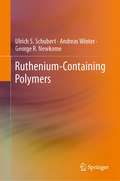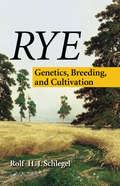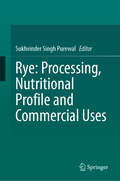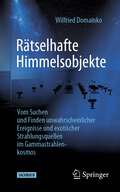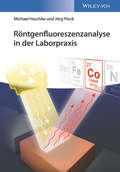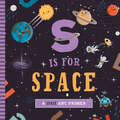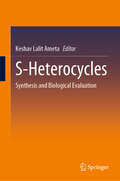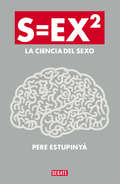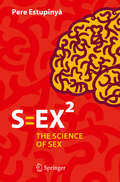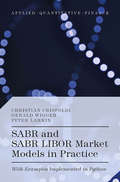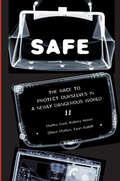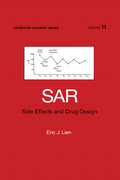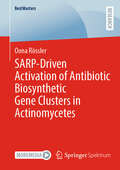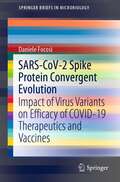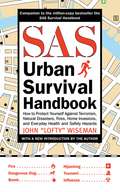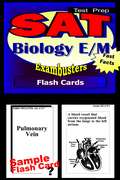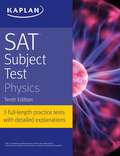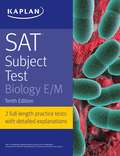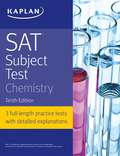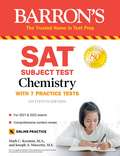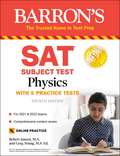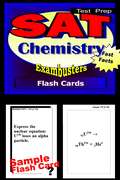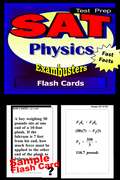- Table View
- List View
Ruthenium-Containing Polymers
by Andreas Winter Ulrich S. Schubert George R. NewkomeThis book presents the synthetic methodologies as well as the properties and potential usage of various ruthenium-containing materials. Starting from the first examples of 'ruthenopolymers' reported in the 1970s to the 3D architectures now synthesized, these materials have shown their importance far beyond fundamental polymer science. As well as highlighting the remarkable properties and versatile applications, this book also addresses a key question related to the applications of such heavy-metal-containing materials from the perspective of achieving a sustainable future. This book is of interest to both materials scientists and chemists in academia and industry.
Rye: Genetics, Breeding, and Cultivation
by Rolf H. SchlegelOwing to its considerable winter hardiness, rye is a cereal that played a major role in the feeding of European populations throughout the Middle Ages. Recent data shows that rye is grown on about 5.4 million hectares, with a world production of approximately 13 million tons. While still an important bread food in many countries, rye produced for b
Rye: Processing, Nutritional Profile and Commercial Uses
by Sukhvinder Singh PurewalCereal grains are gaining interest from food manufacturers and pharmaceutical industries because of their health benefits. In the current day consumers are focusing on diets rich in nutrients and bioactive compounds and researchers are exploring the potential of different cereal grains. Cereal grain possesses a unique blend of macronutrients and micronutrients. Among different cereal grains (wheat, rye, oats, rice, barley and sorghum) rye possess higher amount of arabinoxylan. Rye is the only crop after wheat which possess a significant amount of gluten proteins, and is widely used in food industries throughout the world for the preparation of products such as bread, biscuits, rusk, flakes and beer. Scientific reports on rye considered it an important dietary source as it has well balanced amino acid profile as compared to wheat. Rye grains possess an array of bioactive compounds with antioxidant potential that may help in immunity boosting and countering age-related issues. Rye istraditionally used for the preparation of bread in Northern and Eastern Europe. As a staple food, bread is enjoyed by major part of population, making its quality is of utmost importance. Being an important part of dietary menu, bread should have high nutritional quality. Nutritional profile indicates that bread is a rich source of fibers, proteins along with macro and micronutrients. Rye is a dual-purpose crop used as food and feed and has the potential to be used for medicinal purpose as it is a good source of fibers and antioxidants. Further, starch isolated from rye grains can be utilized as excipient during tablet preparation. Rye starch-based coatings are useful in enhancing the shelf life of fresh cut fruits and whole fruits. After wheat, rye is the only cereal grain which possess gluten, meaning its flour can be used in the preparation of protein and fiber rich bakery products. Rye: Processing, Nutritional Profile and Commercial Uses discusses the physical parameters and health benefiting features of rye, exploring the chemistry of rye components, rye flour and starch properties and proteins and their extraction and industrial uses, antioxidant properties, fiber profile and health benefits, rye flour based important food products and effect of processing on nutritional profile. This is the first scientific text available specifically on rye grains and provides the latest information and updates. Rye's different components such as starch, protein, fiber, bioactive metabolites and their uses in food products are described in detail. Chapters focusing on the specific components of rye grains and their health benefits are included, making this the go-to source for researchers looking for a singular and comprehensive overview of this beneficial crop.
Rätselhafte Himmelsobjekte: Vom Suchen und Finden unwahrscheinlicher Ereignisse und exotischer Strahlungsquellen im Gammastrahlenkosmos
by Wilfried DomainkoDieses Buch erzählt vom Suchen und Finden überraschender Phänomene im Licht der Gammastrahlenastronomie - und zeigt, was wir von noch rätselhaften Himmelsobjekten über das Universum und die Grenzen unseres Wissens lernen können.Das Universum ist von einer unvorstellbaren Zahl an Himmelskörpern bevölkert, von denen sich nicht wenige nach wie vor einer konventionellen Erklärung zu entziehen scheinen. Solche exotischen Strahlungsquellen finden sich besonders im Gammalicht. Anhand ausgewählter Beispiele widmet sich der Autor diesen anomalen Objekten. Er zeigt: Diese Objekte zeugen nicht nur von den extremsten Ereignissen im Kosmos, sondern könnten sogar auf eine bisher unbekannte Physik hindeuten. Und das nicht nur in fernen Ecken des Universums, sondern möglicherweise auch auf der Erde, wie anomale Spuren auf unserem Planeten zeigen. Anschaulich erklärt Wilfried Domainko die innovativen Methoden, die bei der Suche nach diesen exotischen Phänomenen zum Einsatz kommen – und wie die gefundenen Strahlungsquellen unser Weltbild verändern könnten.
Röntgenfluoreszenzanalyse in der Laborpraxis
by Michael Haschke Jörg FlockBereits seit vielen Jahren wird die Röntgenfluoreszenzenzanalyse eingesetzt für die Untersuchung kompakter, homogener Proben wie Metallen oder Gläsern, aber auch für die Analyse pulverförmiger Proben wie etwa geologische Proben, Zement und Eisenlegierungen. In den letzten Jahren haben sich viele neue Applikationsgebiete für diese Methode eröffnet. Im vorliegenden Buch erfolgt zunächst eine kurze Darstellung der physikalischen Zusammenhänge bei der Erzeugung und Wechselwirkung von Röntgenstrahlung in der zu untersuchenden Probe. Dann werden die verschiedenen Methoden der Probenpräparation in Abhängigkeit von der Qualität des Ausgangsmaterials sowie von der analytischen Zielstellung vorgestellt. Nach einer kurzen Beschreibung der verschiedenen Gerätetypen, die in der Röntgenanalytik existieren, und deren Leistungsfähigkeit wird auf die Auswahl optimaler Messbedingungen eingegangen sowie die Aufbereitung der Messdaten erläutert, angefangen von deren Korrektur über die Bestimmung der Intensitäten bis hin zum endgültigen Analysenergebnis, auch unter Berücksichtigung, Vermeidung und Korrektur möglicher auftretender Fehler. Nach einer kurzen Beschreibung der Gefahren einer Schädigung durch Röntgenstrahlung und der Anforderungen zu denen Verhinderung werden die verschiedenen Applikationen der Röntgenfluoreszenz beschrieben.
S Is for Space: A Space ABC Primer
by Ashley Marie MirelesAn out-of-this-world ABC primer from astronaut to zenith and beyond!
S-Heterocycles: Synthesis and Biological Evaluation
by Keshav Lalit AmetaThis book presents the recent research on sulfur-containing heterocyclic scaffolds that are crucial for biological processes. The numerous synthetic techniques utilized for the design and synthesis of different sized S-heterocycles, particularly biologically active frameworks with their pharmacological significance, are discussed in this book. This book is a useful reference for students, researchers and professionals working in the chemical and pharmaceutical industries.
S=EX2: La ciencia del sexo
by Pere EstupinyàUna aproximación al sexo innovadora y original que revolucionará nuestra mente y quizá también nuestro comportamiento. Tienes en tus manos el libro más riguroso, ameno, y completo jamás escrito sobre el fascinante estudio científico de la sexualidad humana. Por amor a la ciencia, Pere Estupinyà, el ladrón de cerebros, se sumerge en una novedosa investigación: participa en un estudio sobre disfunción eréctil y el orgasmo masculino, visita centros de referencia como el prestigioso Instituto Kinsey, se infiltra en clínicas de medicina sexual, acude a congresos internacionales de sexología, y entrevista a científicos expertos en sexualidad. Pero también habla directamente con asexuales, fetichistas, mujeres multiorgásmicas, anorgásmicas, intersexuales, pasa una noche en un club de swingers de Nueva York, participa en eventos sadomasoquistas, habla con actores y actrices porno, y acude a talleres donde una mujer enseña a tener orgasmos con la respiración y la mente. Todo esto acompañado de una revisión exhaustiva de bibliografía científica donde encuentra valiosas publicaciones sobre los procesos inconscientes de la atracción, el sexo online, nuestra naturaleza polígama versus la monógama, la relación entre el placer y el dolor, las disfunciones sexuales más frecuentes, y mucho más. En La ciencia del sexo encontrarás infinidad de anécdotas históricas, consejos prácticos, reflexiones profundas, y respuestas a qué nos ocurre cuando estamos disfrutando de la actividad que más nos interesa, pero que paradójicamente la ciencia tiene más reparos en explorar.
S=ex²
by Pere EstupinyàYou have in your hands the most rigorous, complete and readable book ever written about the fascinating science of human sexuality. This book goes beyond the well-wornsexual education advice and the usual evolutionist psychology. After The BrainSnatcher, Pere Estupinyà comes back with the first popular science book on sexaimed at a wide audience. While there are some tips for the more adventurous, thereis also a wealth of new information to be discovered. Distancing himself from the manybooks on advice or techniques, Estupinyà brings sex to another dimension bycombining popular beliefs and science. Do you want proof that ourdecision-making in the "heat of the moment" is less rational than we think? Didyou know that mind and vagina each go their own way? Are you interested inlearning about the effects of yoga on sexual pleasure? Did you know about theattempts in the 60s to "cure" homosexuals with electric shock therapy, thechemical analysis of female ejaculation, or the fundamental relationshipbetween the sympathetic and parasympathetic nervous system? The author hasspoken directly with asexual and intersexual individuals, fetishists,multi-orgasmic women, women who never have orgasms through penetration, and menwho have no refractory period. He has also participated in sadomasochisticevents; learned tantric techniques with a couple of coaches, spoken with pornperformers at Barcelona's Bagdad, and attended workshops in which a womanteaches how to have orgasms with your mind and breathing. The result is anincredible miscellany of information that appeals to both the scientificcommunity and the curious.
SABR and SABR LIBOR Market Models in Practice: With Examples Implemented in Python (Applied Quantitative Finance)
by Peter Larkin Christian Crispoldi Gérald WiggerInterest rate traders have been using the SABR model to price vanilla products for more than a decade. However this model suffers however from a severe limitation: its inability to value exotic products. A term structure model à la LIBOR Market Model (LMM) is often employed to value these more complex derivatives, however the LMM is unable to capture the volatility smile. A joint SABR LIBOR Market Model is the natural evolution towards a consistent pricing of vanilla and exotic products. Knowledge of these models is essential to all aspiring interest rate quants, traders and risk managers, as well an understanding of their failings and alternatives. SABR and SABR Libor Market Models in Practice is an accessible guide to modern interest rate modelling. Rather than covering an array of models which are seldom used in practice, it focuses on the SABR model, the market standard for vanilla products, the LIBOR Market Model, the most commonly used model for exotic products and the extended SABR LIBOR Market Model. The book takes a hands-on approach, demonstrating simply how to implement and work with these models in a market setting. It bridges the gap between the understanding of the models from a conceptual and mathematical perspective and the actual implementation by supplementing the interest rate theory with modelling specific, practical code examples written in Python.
SAFE: Science and Technology in the Age of Ter
by Martha Baer Katrina Heron Olivia Morton Evan RathffIf our society is the most technologically sophisticated on Earth, then why can't we protect ourselves from terrorists and other threats to our safety and security? This is the question that frustrates—and scares—all of us today, and the answers have proved maddeningly elusive. Until now. Through dramatic, enlightening, and often entertaining narratives, SAFE makes visible—and understandable—the high-stakes work being done by some of the most ingenious problem-solvers across the country and around the world, people committed to creating real and dependable security in the twenty-first century.The characters in these pages, from scientists and engineers to academics, entrepreneurs, and emergency workers, take us into a fascinating world of inquiry and discovery. Their stories reveal where our greatest vulnerabilities lie and where our best hope deservedly shines through. They show why the systems we rely on to protect ourselves can also be exploited by others to create catastrophe—and what we can do to outsmart the terrorists. We have ample proof that terrorists will go to great lengths to understand how our technologies can be put to destructive use. Now it's time to ask ourselves a question: Are we willing to let them keep beating us at our own game? For the brilliant and colorful innovators in these pages, the answer is no.Among them are Eric Thompson, an expert digital code breaker instrumental in deciphering hidden Al Qaeda messages; Mike Stein, a New York City firefighter turned technologist who is working to overcome the numerous communications failures of 9/11; Eve Hinman, who conducts structural autopsies at the scene of explosions, including the Oklahoma City bombing, in order to develop more blast-resistant designs; Ken Alibek, the infamous architect of the former Soviet bioweapons program and now an American entrepreneur working in the business of defending his adopted country from bioterrorism; Kris Pister and Michael Sailor, university researchers developing sensors no larger than a speck of dust; Rafi Ron, former head of security for Ben Gurion Airport in Tel Aviv and now a leading strategist on U.S. airport security; Tara O'Toole, who stages doomsday bioterror scenarios in order to craft better biodefense systems; and Jeff Jonas, a high-rolling Las Vegas software entrepreneur whose methods for spotting casino cheats might just have uncovered the 9/11 plot.Readers of SAFE will come away understanding the unique challenges posed by technological progress in a networked, and newly dangerous, world. Witnessing the work of this gathering force of innovators up close, they'll be inspired by the power of the human intellect and spirit—and realize how important the contributions of individual citizens and communities can be.
SAR: Side Effects and Drug Design
by Eric J. LienThis book focuses on the quantitative structure-activity relationship of the disposition and activities of various pharmacological groups. It presents a systematic approach for linking different side effect of drugs to their molecular structure and physiochemical properties.
SARP-Driven Activation of Antibiotic Biosynthetic Gene Clusters in Actinomycetes (BestMasters)
by Oona RösslerActinomycetes are a group of Gram-positive bacteria of which many representatives are prominent for being prolific producers of bioactive natural products including antibiotics, fungicides, antitumor agents, or immunosuppressants. SARP transcriptional regulators are widely distributed among actinomycetes, especially in streptomycetes and are known to activate antibiotic biosynthesis. The set of genes responsible for the production of natural products, including pathway specific transcriptional regulators such as SARPs, are typically located in contiguous regions of the genome known as "biosynthetic gene clusters" (BGCs). In this book, Oona Rössler reports on the activation of antibiotic BGCs in selected actinomycetes strains upon heterologous expression of the SARP-type regulator PapR2 from Streptomyces pristinaespiralis. Applying a bioinformatic screening for the abundance of SARP genes and SARP consensus sequences as part of BGCs, the author has selected actinomycetes candidate strains from the DSMZ strain collection for heterologous SARP expression. It is shown that overexpression of papR2 increased the production of predominantly unknown antimicrobial compounds in more than half of the selected actinomycetes strains, as observed by bioassays against different microbial test strains including bacteria and fungi.
SARS-CoV-2 Spike Protein Convergent Evolution: Impact of Virus Variants on Efficacy of COVID-19 Therapeutics and Vaccines (SpringerBriefs in Microbiology)
by Daniele FocosiThis book reviews the current knowledge of the globally circulating SARS-CoV-2 variants, highlights their distinct genetic characteristics and associated conformational changes in the viral spike protein, and profoundly discusses the mechanisms of convergent evolution that led to the rise of these mutated strains at different geographic regions during the Covid-19 pandemic. Furthermore, the book explores how these variants do and may impact the efficacy of established neutralizing antibody-based (nAb) vaccines and therapeutics by analysing latest in vivo and in vitro clinical data. Finally, the author discusses ways on how nAb Covid-19 treatment derived immune escape of SARS-CoV-2 could be minimized in the future.
SAS Urban Survival Handbook: How to Protect Yourself Against Terrorism, Natural Disasters, Fires, Home Invasions, and Everyday Health and Safety Hazards
by John Lofty" WisemanJohn "Lofty" Wiseman is the author of the bestselling SAS Survival Handbook, the definitive guide to survival in the wild from Britain's Special Air Service. Now he has compiled a complete guide to survival in the urban jungle. Every year in America there are thousands of fatal accidents in the home—more than on the roads, and many more than in the great outdoors. Fire, electricity, water, gas, sharp knives, poisons, chemicals—these valuable tools can quickly become dangerous weapons when not treated with proper respect and understanding. Add to these the risks of travel, terrorism, muggings, rape, tsunamis, and earthquakes. We are constantly reminded that the world is a dangerous place. Wiseman shows readers how to think realistically and practically about these perils in order to avoid them, whether they are at home, on the street, in school, or in transit. From self-defense techniques to home security systems to coping with natural disasters, this book will teach readers to recognize risks, make quick decisions, and live confidently in the modern urban world.
SAT Biology E/M Test Prep Review: Exambusters Flash Cards and SAT II Exam Study Guide (Exambusters SAT 2 #1)
by Ace Inc.<P><P><i>Advisory: Bookshare has learned that this book offers only partial accessibility. We have kept it in the collection because it is useful for some of our members. Benetech is actively working on projects to improve accessibility issues such as these.</i><P><P> SAT BIOLOGY E/M Study Guide:<P><P> 450 questions and answers. Essential definitions and concepts. Topics: Cells, Biochemistry and Energy, Evolution and Classification, Kingdoms: Bacteria, Fungi, Protista; Kingdom: Plantae, Kingdom: Animalia, Human Locomotion, Human Circulation and Immunology, Human Respiration and Excretion, Human Digestion, Human Nervous System, Human Endocrinology, Reproduction and Development, Genetics, Ecology. <P> EXAMBUSTERS SAT II Prep Workbook:<P> Provides comprehensive SAT II review--one fact at a time--to prepare students to take practice SAT II tests. Each SAT II study guide focuses on fundamental concepts and definitions--a basic overview to begin studying for the SAT II exam. Up to 600 questions and answers, each volume in the SAT II series is a quick and easy, focused read. Reviewing SAT II flash cards is the first step toward more confident SAT II preparation and ultimately, higher SAT II exam scores!
SAT Subject Test (Tenth Edition): Physics
by Hugh HendersonKaplan's SAT Subject Test Physics is the most up-to-date guide on the market with the essential content, practice, and strategies students need for success on Test Day. Kaplan's expert tips and focused review will help you ace the test and give your college applications a boost.<P><P> Contents: Essential Review; Three full-length practice tests with detailed answer explanations; A full-length diagnostic test identifies areas for score improvement so you can personalize your prep; Focused chapter summaries, highlights, and quizzes; End-of-chapter quizzes for additional practice; Proven score-raising strategies teach you how to tackle the test efficiently; Expert Guidance. <P>We know the test: Our Learning Engineers have put tens of thousands of hours into studying the SAT – using real data to design the most effective strategies and study plans. Kaplan's expert psychometricians make sure our practice questions and study materials are true to the test.We invented test prep—Kaplan (www.kaptest.com) has been helping students for almost 80 years, and more than 95% of our students get into their top-choice schools. Our proven strategies have helped legions of students achieve their dreams.
SAT Subject Test Biology E/M
by KaplanEssential strategies, practice, and review to ace the SAT Subject Test Biology E/M Getting into a top college has never been more difficult. Students need to distinguish themselves from the crowd, and scoring well on an SAT Subject Test gives students a competitive edge. Kaplan’s SAT Subject Test Biology E/M is the most up-to-date guide on the market with complete coverage of both the content review and strategies students need for success on Test Day. Kaplan’s SAT Subject Test Biology E/M features: * A full-length diagnostic test * 2 full-length practice tests * Focused chapter summaries, highlights, and quizzes * Detailed answer explanations * Proven score-raising strategies * End-of-chapter quizzes Kaplan is serious about raising students’ scores—we guarantee students will get a higher score, or get their money back.
SAT Subject Test Chemistry
by KaplanEssential strategies, practice, and review to ace the SAT Subject Test Chemistry Getting into a top college has never been more difficult. Students need to distinguish themselves from the crowd, and scoring well on an SAT Subject Test gives students a competitive edge. Kaplan’s SAT Subject Test Chemistry is the most up-to-date guide on the market with complete coverage of both the content review and strategies students need for success on Test Day. Kaplan’s SAT Subject Test Chemistry features: * A full-length diagnostic test * 3 full-length practice tests * Focused chapter summaries, highlights, and quizzes * Detailed answer explanations * Proven score-raising strategies * End-of-chapter quizzes Kaplan is serious about raising students’ scores—we guarantee students will get a higher score, or get their money back.
SAT Subject Test Chemistry: with 7 Practice Tests (Barron's SAT)
by Joseph A. Mascetta M.S. Mark Kernion M.A.The updated edition of Barron's SAT Subject Test: Chemistry includes:A full-length diagnostic test with explained answersFour practice tests that reflect the actual SAT Subject Test ChemistryAll questions answered and explainedDetailed reviews covering all test topicsAppendixes, which include the Periodic Table; important equation, constant, and data tables; and a glossary of chemistry termsBoth teachers and test-taking students have praised earlier editions of this manual for its wealth of well-organized detail. Subject reviewed include the basics—matter, energy, scientific method, and measurements; atomic structure and the periodic table; bonding; chemical formulas; gases and laws; stoichiometry; liquids, solids, and phase changes; chemical reactions and thermochemistry; chemical reactions; chemical equilibrium; acids, bases, and salts; oxidation-reduction; carbon and organic chemistry; and the laboratory.ONLINE PRACTICE TESTS: Students who purchase this book or package will also get access to two additional full-length online SAT Chemistry subject tests with all questions answered and explained.
SAT Subject Test Physics: With Online Tests (Barron's Test Prep)
by Robert Jansen M.A. Greg Young M.S. Ed.Barron's SAT Subject Test Physics is updated to reflect the current test and features three full-length practice tests along with detailed content review and expert tips to help students improve their score.This edition includes:One diagnostic test to determine strengths and weaknessesThree complete SAT Subject Tests in Physics, which reflect the most recent actual tests in length, subject matter, and degree of difficultyAnswers and explanations for all questionsSelf-assessment guides after each test so students can measure their progressExtensive subject review covering all topics on the test, including mechanics, electricity and magnetism, waves and optics, thermodynamics, and more.Online Practice Test: Students also get access to one brand new, full-length online practice test with all questions answered and explained.Unique features include a &“What&’s the Trick?&” approach to solving problems quickly and effectively. Additional tips, called out with &“If You See…&” are included within the chapters to give test takers critical insight into difficult concepts, and QR codes are provided at &“Key Concept&” areas link to short videos to enhance instruction. The authors also provide general examination strategies and a detailed appendix with equations, physical constants, and a basic math review.
SAT Test Prep Flash Cards: Chemistry Fast Facts (Exambusters SAT II Workbook #2)
by Ace Inc.<P><P><i>Advisory: Bookshare has learned that this book offers only partial accessibility. We have kept it in the collection because it is useful for some of our members. Benetech is actively working on projects to improve accessibility issues such as these.</i><P><P> 700 questions and answers. Essential definitions, formulas, concepts, and sample problems. <P><P>Topics: Introduction, Matter, Atoms, Formulas, Moles, Reactions, Elements, Periodic Table, Electrons, Chemical Bonds, Heat, Gases, Phase Changes, Solutions, Reaction Rates, Equilibrium, Acids and Bases, Oxidation and Reduction, Introduction to Organic Chemistry, Radioactivity.<P> EXAMBUSTERS SAT II Prep Workbooks Provide comprehensive SAT II review--one fact at a time--to prepare students to take practice SAT II tests. Each SAT II study guide focuses on fundamental concepts and definitions--a basic overview to begin studying for the SAT II exam. Up to 600 questions and answers, each volume in the SAT II series is a quick and easy, focused read. Reviewing SAT II flash cards is the first step toward more confident SAT II preparation and ultimately, higher SAT II exam scores!
SAT Test Prep Review Flash Cards: Physics (Exambusters SAT II Workbook #2 of 3)
by Ace Inc.<P><P><i>Advisory: Bookshare has learned that this book offers only partial accessibility. We have kept it in the collection because it is useful for some of our members. Benetech is actively working on projects to improve accessibility issues such as these.</i><P><P> 600 questions and answers. Essential definitions, formulas, concepts, and sample problems. <P><P>Topics: Measurement, Motion and Forces, Work and Energy, Heat and Gases, Atoms, Fluids, Sound, Light and Optics, DC Circuits, Magnetism, AC Circuits <P>EXAMBUSTERS SAT II Prep Workbooks provide comprehensive SAT II review--one fact at a time--to prepare students to take practice SAT II tests. Each SAT II study guide focuses on fundamental concepts and definitions--a basic overview to begin studying for the SAT II exam. Up to 600 questions and answers, each volume in the SAT II series is a quick and easy, focused read. Reviewing SAT II flash cards is the first step toward more confident SAT II preparation and ultimately, higher SAT II exam scores!
SBIR at the National Science Foundation
by Technology Committee on Capitalizing on Science Innovation An Assessment Of The Small Busin Program-Phase IIThe Small Business Innovation Research (SBIR) program is one of the largest examples of U. S. public-private partnerships, and was established in 1982 to encourage small businesses to develop new processes and products and to provide quality research in support of the U. S. government’s many missions. The U. S. Congress tasked the National Research Council with undertaking a comprehensive study of how the SBIR program has stimulated technological innovation and used small businesses to meet federal research and development needs, and with recommending further improvements to the program. In the first round of this study, an ad hoc committee prepared a series of reports from 2004 to 2009 on the SBIR program at the five agencies responsible for 96 percent of the program’s operations -- including the National Science Foundation (NSF). Building on the outcomes from the first round, this second round presents the committee’s second review of the NSF SBIR program’s operations. Public-private partnerships like SBIR are particularly important since today's knowledge economy is driven in large part by the nation's capacity to innovate. One of the defining features of the U. S. economy is a high level of entrepreneurial activity. Entrepreneurs in the United States see opportunities and are willing and able to assume risk to bring new welfare-enhancing, wealth-generating technologies to the market. Yet, although discoveries in areas such as genomics, bioinformatics, and nanotechnology present new opportunities, converting these discoveries into innovations for the market involves substantial challenges. The American capacity for innovation can be strengthened by addressing the challenges faced by entrepreneurs.
SBIR/STTR at the National Institutes of Health
by Technology Committee on Capitalizing on Science Innovation An Assessment Of The Small Busin Program-Phase IIThe Small Business Innovation Research (SBIR) and Small Business Technology Transfer (STTR) programs provide federal research and development funding to small businesses. In 2008, the National Research Council completed a comprehensive assessment of the SBIR and STTR programs. The first-round study found that the programs were "sound in concept and effective in practice. " Building on the outcomes from the Phase I study, this second phase examines both topics of general policy interest that emerged during the first phase and topics of specific interest to individual agencies, and provides a second snapshot to measure the program's progress against its legislative goals.
